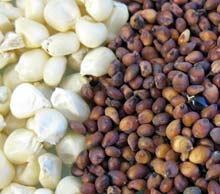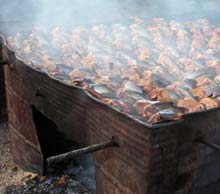2 publications dans Food Chain
La revue Food Chain a publié deux articles liés au projet After.
Production, consumption, and quality attributes of Akpan - a yoghurt-like cereal product from West Africa
Sacca C., Adinsi L., Anihouvi V., Akissoé N.H., Dalodé G., Mestres C., Jacobs A., Dlamini N., Pallet D., Hounhouigan J.D.. 2012. Food Chain, 2 (2) : 207-220.
Résumé :
Akpan is a high-potential, traditional yoghurt-like product made from fermented cereal starch, and consumed as a thirst-quenching beverage in Benin. This study investigated the characteristics of consumers, the traditional processing techniques and constraints, and the quality attributes of the product in order to find out the best options for possible industrial development. For this purpose, a survey was carried out in different municipalities using a questionnaire administered to stakeholders. While the production and commercialization of Akpan are undertaken exclusively by women, consumption cuts across all classes of people, with consumers in a wide range of socio-cultural groups, ages, and educational levels. Four types of Akpan were encountered, varying in their raw materials and processing technologies. Maize and sorghum were used either singly or in combination through submerged or solid-state fermentation processes. Among the product types, Akpan from maize ogi was the most preferred, mainly because of its long-established history, white colour, sour taste, and pronounced ogi aroma.
Pour acheter l'article
Thématique : Traitement et conservation des produits alimentaires; Composition des produits alimentaires; Economie de la consommation
Production, consumption, and quality attributes of Lanhouin, a fish-based condiment from West Africa
Kindossi J., Anihouvi V., Vieira-Dalodé G., Akissoé N.H., Jacobs A., Dlamini N., Pallet D., Hounhouigan J.D.. 2012. Food Chain, 2 (1) : 117-130.
Résumé :
Indigenous knowledge related to Lanhouin processing, commercialization, and consumption was investigated through a survey in the Mono District in the south of Benin using a questionnaire. The questionnaire focused on the socio-cultural profile of actors, the raw materials used for the processing, the technologies used, the quality attributes, the forms of consumption, and the storage of the product. The data collected were analysed by means of descriptive statistics and correspondence analysis. The results showed that Lanhouin is generally processed in informal small-scale plants. A large number of women are engaged in the production and the trade of Lanhouin and this constitutes the main source of income for most of them. Three variants of technologies were used to produce Lanhouin, but all apparently concluded in the same end product. The appreciation of the quality of Lanhouin by the actors is mainly based on sensory attributes such as the colour, texture, aroma, consistency of flesh, and the general appearance of the product. In Benin, Lanhouin serves various markets: domestic markets and sub-regional markets that contribute to an expanding market. As regards the forms of consumption, Lanhouin is used as a taste and flavour enhancing condiment in some main dishes such as vegetable, slimy vegetable, and tomato sauces.
Pour acheter l'article
Thématique : Economie de la consommation; Commerce, commercialisation et distribution; Traitement et conservation des produits alimentaires
Production, consumption, and quality attributes of Lanhouin, a fish-based condiment from West Africa
Publiée : 14/01/2013



